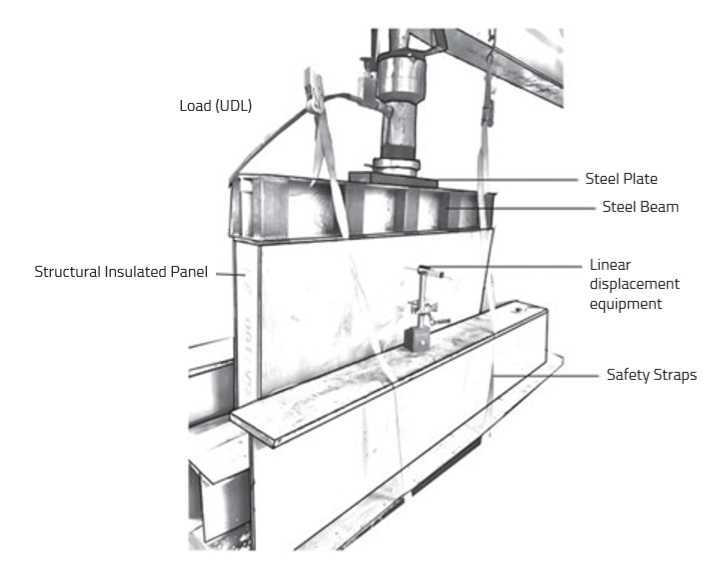Building a safe and therapeutic hospice
The research and its outcomes in 'Building a Safe and Therapeutic Hospice: An Evaluation of Structural and Thermal properties in Structural Insulated Panels' shows how a project can improve user comfort and reduce costs. It was awarded Commended for the Student Award for Excellence in Architectural Technology (Report) 2017. Isabelle Foster writes about her report.
The report aims to investigate how advanced technology and innovative construction methods can be adapted to increase the quality and performance of buildings. The key focus of the report is to showcase how a range of eco-friendly materials for the specific purpose of wall construction, can be used as an alternative way to build future hospices in the UK, and to surmount the challenges that traditionally built hospices face.
In order to ensure that modern hospices meet patients’ requirements, this report explores the benefits of Structural Insulated Panels (SIPs) due to the need for a careful consideration of the control of quality and the improvement of the building’s energy efficiency.
This technical research investigates whether the wall construction of SIPs can achieve a better suited hospice environment, which is suitably adapted to meet the needs of terminally ill patients, and to assess if this pre-fabrication method can compete as the future’s leading method of building in the UK.
In the future, with the advancement of technology and through research, building construction will continue to recognise the development and importance of being an inclusive designer to meet the specific requirement of the end user as well as examining the impact in relation to the environment, functionality and building performance.

In consideration of the brief, I carefully chose to focus on how, through specific design requirements, we as Architectural Technologists can influence social and environmental issues as well as the wellbeing of the community. With a range of materials, I investigated the performance of the construction material as a Structural Insulated Panel and evaluated which combination of materials can provide an energy efficient and high building performance to formulate outcomes that can be applied into the design of a hospice.
Of particular interest during this research were the outstanding benefits that SIPs could potentially add to an exceptional detail in combination with several other components of conventional buildings.
As an Architectural Technologist, I was able to gather structural data analysis, provide U-value calculations and assess the technical specification of each material to understand the key benefits, performance of the panels and also possible technical solutions that can implemented when adapted as a building system.
To further my research, I focused on creating sustainable combinations of SIPs, looking at materials that are environmentally friendly and which can be constructed with an effective improvement of the life cycle of the building. An example of this was the use of bamboo as a honeycomb structure to add strength to the sandwiched panel, it was interesting to see how bamboo can be relatively combined into a structure in many different ways.
The key findings from the results demonstrate that the performance of SIPs qualify them as an effective alternative method of construction and possess adequate factors needed to build a hospice environment that is suitable to meet the needs of patients. This modern method of construction meets the objectives in achieving a controlled quality in construction at a better economic value.
Judges’ comments:
Isabelle’s report explored advanced technology and innovative construction trends, such as modern methods and off-site construction, to improve the comfort of terminally ill patients in hospices through the use of SIPs. The key focus of this report is to showcase how a range of eco-friendly materials for the specific purpose of wall construction, can be used as an alternative way to build future hospices in the UK. Judges commended this research for showing true potential in the field which would greatly improve user comfort, whilst reducing economic and workmanship costs on such projects.
This article was originally published in AT Autumn 2017.
--CIAT
[edit] Related articles on Designing Buildings Wiki
Featured articles and news
RTPI leader to become new CIOB Chief Executive Officer
Dr Victoria Hills MRTPI, FICE to take over after Caroline Gumble’s departure.
Social and affordable housing, a long term plan for delivery
The “Delivering a Decade of Renewal for Social and Affordable Housing” strategy sets out future path.
A change to adoptive architecture
Effects of global weather warming on architectural detailing, material choice and human interaction.
The proposed publicly owned and backed subsidiary of Homes England, to facilitate new homes.
How big is the problem and what can we do to mitigate the effects?
Overheating guidance and tools for building designers
A number of cool guides to help with the heat.
The UK's Modern Industrial Strategy: A 10 year plan
Previous consultation criticism, current key elements and general support with some persisting reservations.
Building Safety Regulator reforms
New roles, new staff and a new fast track service pave the way for a single construction regulator.
Architectural Technologist CPDs and Communications
CIAT CPD… and how you can do it!
Cooling centres and cool spaces
Managing extreme heat in cities by directing the public to places for heat stress relief and water sources.
Winter gardens: A brief history and warm variations
Extending the season with glass in different forms and terms.
Restoring Great Yarmouth's Winter Gardens
Transforming one of the least sustainable constructions imaginable.
Construction Skills Mission Board launch sector drive
Newly formed government and industry collaboration set strategy for recruiting an additional 100,000 construction workers a year.
New Architects Code comes into effect in September 2025
ARB Architects Code of Conduct and Practice available with ongoing consultation regarding guidance.
Welsh Skills Body (Medr) launches ambitious plan
The new skills body brings together funding and regulation of tertiary education and research for the devolved nation.
Paul Gandy FCIOB announced as next CIOB President
Former Tilbury Douglas CEO takes helm.
UK Infrastructure: A 10 Year Strategy. In brief with reactions
With the National Infrastructure and Service Transformation Authority (NISTA).
























